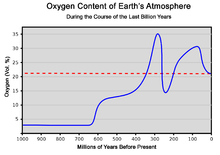Palaeozoic
The Palaeozoic (or Paleozoic) era is the earliest of the three eras of the Phanerozoic. Its name means early life. It lasted from about 541 to 252 million years ago (mya), and ended with the greatest extinction event, the Permian–Triassic extinction event.
Beginning
The Palaeozoic began with an explosion of life forms. The Cambrian explosion marks the era with thousands of new life forms in the ancient seas. The era saw many important events, including the development of most invertebrate groups, life's conquest of land, the evolution of fish, reptiles, synapsids (the ancestors of mammals), amphibians, insects, and plants, the formation of the supercontinent of Pangea, and at least two distinct ice ages. The earth rotated faster than it does today so days were shorter, and the nearer moon caused stronger tides.
Oxygen and CO2 levels

At the start of the long Carboniferous period oxygen was low and carbon dioxide was high. The huge growth of trees and other plants during this time reversed these data. The carbon dioxide level dropped throughout the Carboniferous, and the oxygen level rose continuously until it dropped in the Permian.[2]
Oxygen reached a peak of about 30% about 280 million years ago.[3] That is much higher than today's 21%.
Periods
The six periods of the Palaeozoic are: